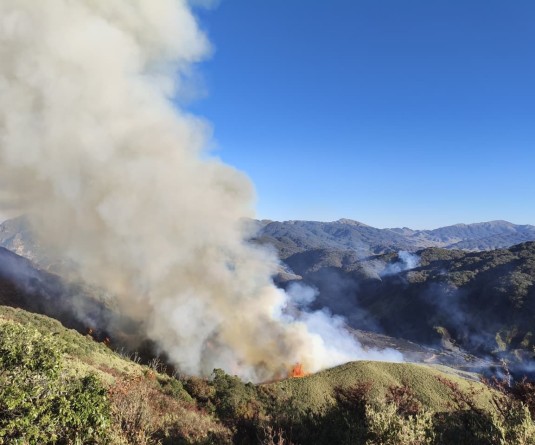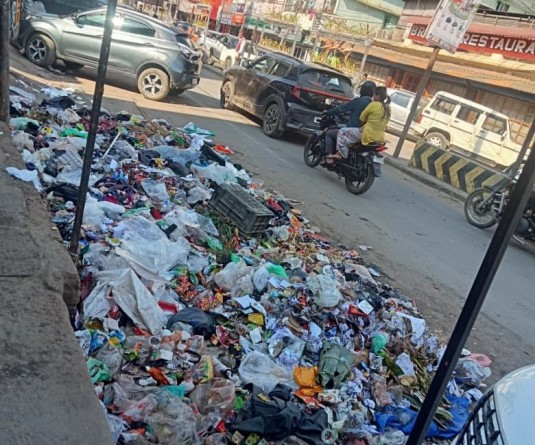
Khiamniungan Nagas condemn Govt of India and Myanmar move to fence 3500 acres of Naga lands
Noklak, January 2 (MExN): The Government of India and the Government of Myanmar now seem to be collaborating to divide indigenous lands through physical fencing, leaving people without access to their ancestral lands and livelihood.
Despite opposition from the indigenous people here, the two governments have begun preparations to seal off 3500 acres of Khiamniungan Naga land, which will also result in a loss of livelihood for the people. The Khiamniungan people have condemned this “policy of separation” and termed the move a “felonious act.”
“We the people of Wolam (Pangsha) vehemently condemn both the Govt. of India and Myanmar for such inhuman act, and we strongly oppose the policy of mending fence and separation in our land,” stated the Chairman of the New Pangsha Village Council in a press statement today.
Explaining the situation, Chairman of New Pangsha Village Council, P Shingnya, stated that “Decades of centuries since the origin, we lived as Khiamniungan in our inherent territory. This land was not given by any foreigners but inherited by our ancestors.”
The Khiamniungan people of the Pangsha and Pounyiu villages, neighbouring each other, stand to be divided by the imaginary international border lines between the Indian Union and Myanmar.
“Pangsha and Pounyiu lived as neighbours; we had never fought or had any disputes till today. Unfortunately, today we see Indo-Burma Khiamniungan separated from each other by drawing the imaginary lines from Border Pillar Nos. 139 to 146 between India and Myanmar keeping the indigenous people deprived of ownership of land,” stated the office of the New Pangsha Village Council in a press statement today.
It informed that border pillar no. 146, which runs through their land, was instated in 1970-1971 as an “undisclosed covert act” without the consent of the people.
Affirming that “we do not deny any one’s own country’s border line,” the Chairman of the New Pangsha Village Council stated that despite the “imaginary line 146,” Pangsha and Pounyiu lived in peace and respected the “fundamental concept of International boundary line till today.”
It also noted that there is no such dispute between India and Myanmar which demands the erecting of a fence between the two countries.
“Today, we shed our tears for such felonious act of the Indian Govt. and Myanmar Govt. tearing off the inherent wealth and peaceful environment of our people. Imaginary line was enough for the Indo-Burmese Khiamniungan Naga, and now dismantling and drawing the geographical trench is a sign of trying to divide the native people inviting the unforeseen circumstances of war and hatred between the two brothers living both in India and Myanmar,” maintained the Village Council Chairman.
Policy of separation and loss of livelihood
The village registered a strong opposition to this “policy of separation.”
It explained that 160 Khiamniungan villages fall under Myanmar. As per the ongoing survey for border fencing, 3500 acres of Pangshas’ land goes into Myanmar “which was and is our livelihood.”
“We have been living as Indian for years. We are your sons and daughters, and now with this act of separation, all our hope is gone as with the allocation of our cultivable land to the other side from where we have been sustained,” stated the press note.
In addition to generational damage, the construction of the border trench at International Trade Centre (ITC, Dan) has “spoiled the water pipe-line connections, and reckless cutting of forest belonging to the native people, showing your merciless act towards the people of Pangsha,” stated the New Pangsha Village Council.
Ground reality
Seeking the urgent attention of both the Indian and Myanmar governments, the Khiamniungan Tribal Council (KTC) had written to Prime Minister Narendra Modi and Myanmar President U. Htin Kyaw, urging them to halt the fencing work, as they were not consulted on the issue.
“We have been using the land for Jhum cultivation for so long. Though the border pillars were set up in the middle of our lands all of a sudden, we did not object as it did not stop our people from passing through. Now all of a sudden what is the meaning of constructing fencing between the border pillars?” S. Puthein, Chairman of Village Council Dan, a village of Khiamniungan on the Indian side of the border, said.
When contacted, the Ministry of Home Affairs said that India was not involved in the construction of the fence.
“Ministry of Home has not proposed any fence on the Indo-Myanmar border. On this issue the MEA has been apprised as it is their subject. We have told our people that there will be no construction in our zone and also there will no construction in non-construction zone. Assam Rifles will ensure that,” Pradeep Gupta, Joint Secretary (Border Management) in the ministry, told IANS.
“If the Myanmar government is doing this, then we will ensure that no construction is done in the 10 metres of no-construction zone. The government is trying to clear all the doubts of the locals living in the border areas on this,” said Gupta.
In 2013, the Indian government had to stop fencing work across Manipur’s border with Myanmar following allegations that it passed through Indian land in many parts.
Khriezo Yhome, an expert on Indo-Myanmar affairs at the Observer Research Foundation (ORF) said: “It is important for the two countries to understand the ground realities. The fencing will have an adverse impact on the lives of local people living there.”
He said the challenge was that, on the ground, the boundary lines are not crystallised. “India and Myanmar have a free movement regime (FMR), which allows local tribals to travel 16 km on each side of the boundary. In such situation, if the fencing comes, then it will be contradicting the FMR,” Yhome told IANS.
A lot of villagers from the Myanmar side come to the Indian side to buy basic essentials. “The boundary lines cut across houses, lands and villages of the tribal people living there. This is not just confined to Nagaland but in several bordering areas of Arunachal Pradesh, Mizoram and Manipur,” said Yhome.
With inputs from IANS




.jpg)

